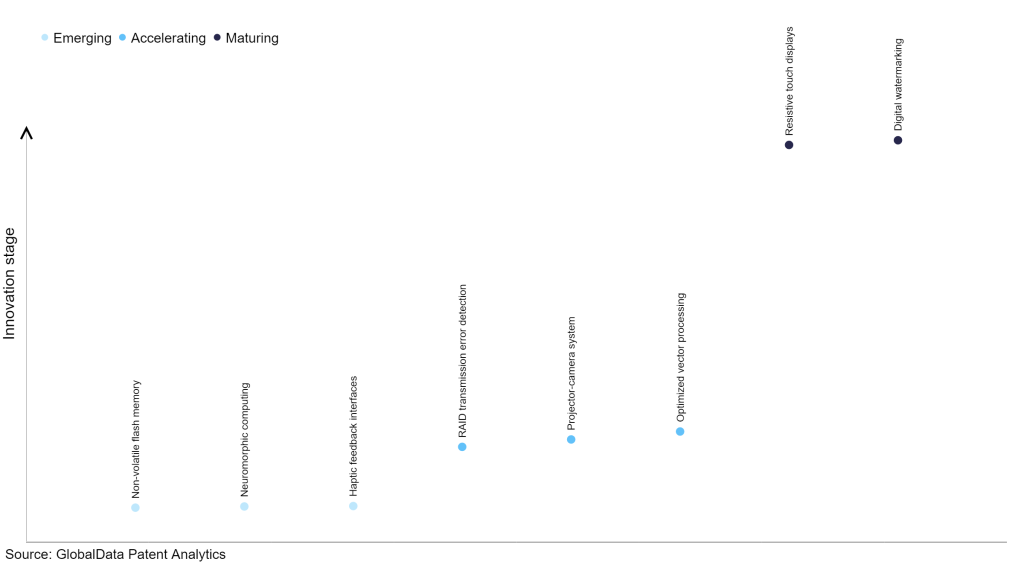The technology industry continues to be a hotbed of patent innovation. Activity is driven by the growing consumer demand for more versatile and durable electronic devices, as well as the desire for larger screen sizes in portable devices, coupled with the need for compact and foldable form factors, and growing importance of technologies such as flexible organic Light Emitting Diode (OLED) and thin-film transistor (TFT). In the last three years alone, there have been over 1.5 million patents filed and granted in the technology industry, according to GlobalData’s report on Innovation in technology: bendable displays. Buy the report here.

Access deeper industry intelligence
Experience unmatched clarity with a single platform that combines unique data, AI, and human expertise.
However, not all innovations are equal and nor do they follow a constant upward trend. Instead, their evolution takes the form of an S-shaped curve that reflects their typical lifecycle from early emergence to accelerating adoption, before finally stabilizing and reaching maturity.
Identifying where a particular innovation is on this journey, especially those that are in the emerging and accelerating stages, is essential for understanding their current level of adoption and the likely future trajectory and impact they will have.
185+ innovations will shape the technology industry
According to GlobalData’s Technology Foresights, which plots the S-curve for the technology industry using innovation intensity models built on over 1.6 million patents, there are 185+ innovation areas that will shape the future of the industry.
Within the emerging innovation stage, non-volatile flash memory, neuromorphic computing, and haptic feedback interfaces are disruptive technologies that are in the early stages of application and should be tracked closely. RAID transmission error detection, projector-camera system, and optimized vector processing are some of the accelerating innovation areas, where adoption has been steadily increasing. Among maturing innovation areas are resistive touch displays and digital watermarking, which are now well established in the industry.
Innovation S-curve for the technology industry

Bendable displays is a key innovation area in technology
Bendable displays are screens or panels that offer flexibility, enabling them to be bent or folded without causing harm to the device. This characteristic allows for the creation of more resilient and space-saving designs. These displays belong to the category of flexible display technology, utilizing materials capable of withstanding frequent bending and folding.
GlobalData’s analysis also uncovers the companies at the forefront of each innovation area and assesses the potential reach and impact of their patenting activity across different applications and geographies. According to GlobalData, there are 120 companies, spanning technology vendors, established technology companies, and up-and-coming start-ups engaged in the development and application of bendable displays.
Key players in bendable displays – a disruptive innovation in the technology industry
‘Application diversity’ measures the number of applications identified for each patent. It broadly splits companies into either ‘niche’ or ‘diversified’ innovators.
‘Geographic reach’ refers to the number of countries each patent is registered in. It reflects the breadth of geographic application intended, ranging from ‘global’ to ‘local’.
Among the companies innovating in bendable displays, Compal Electronics is one of the leading patents filers. The company’s patents are aimed at describing a foldable electronic device comprising a primary body, a secondary body, and a dual-shaft hinge module. The secondary body features two opposing reference planes. The dual-shaft hinge module incorporates a pair of shafts, one attached to the primary body and the other to the secondary body, with the latter functioning as a cam shaft. The cam section of this shaft contacts a set of stop elements on the secondary body. Through the dual-shaft hinge module, the primary body can rotate in relation to the secondary body. As the primary body transitions from a state where it overlaps with the first reference plane to one where it overlaps with the second reference plane, the cam section exerts pressure on the stop elements, causing the secondary body to move away from the primary body. Other prominent patent filers in the space include Samsung Group and Microsoft.
In terms of application diversity, Samsung Group leads the pack, while Microsoft and Hon Hai Precision Industry stood int he second and third positions, respectively. By means of geographic reach, Shenzhen Royole Technologies held the top position, followed by Intel and Mitsubishi Electric.
Bendable displays mark a significant advancement in screen technology, offering a level of flexibility and durability that was previously unattainable with rigid screens. The innovation enables the creation of devices with versatile form factors, allowing them to be folded, rolled, or curved without damaging the display. The significance of bendable displays lies in their potential to revolutionize the design of electronic devices, leading to more compact and portable gadgets. Additionally, these displays open new possibilities for creative and functional applications in industries such as consumer electronics, automotive displays, and wearable technology. Their impact on user experience and device durability makes them a pivotal technology in the evolution of electronic displays.
To further understand the key themes and technologies disrupting the technology industry, access GlobalData’s latest thematic research report on Technology.
Data Insights
From

The gold standard of business intelligence.
Blending expert knowledge with cutting-edge technology, GlobalData’s unrivalled proprietary data will enable you to decode what’s happening in your market. You can make better informed decisions and gain a future-proof advantage over your competitors.







